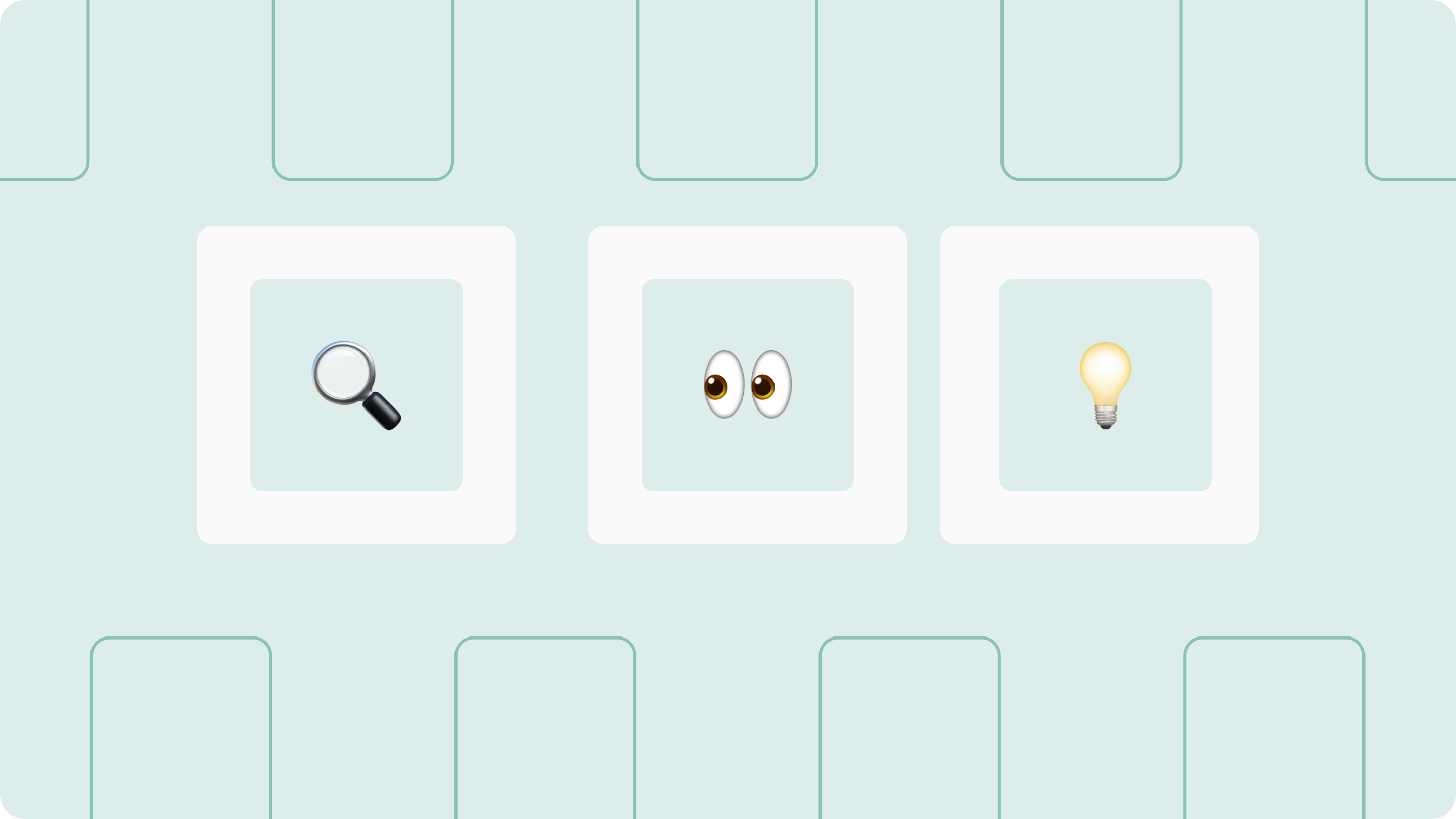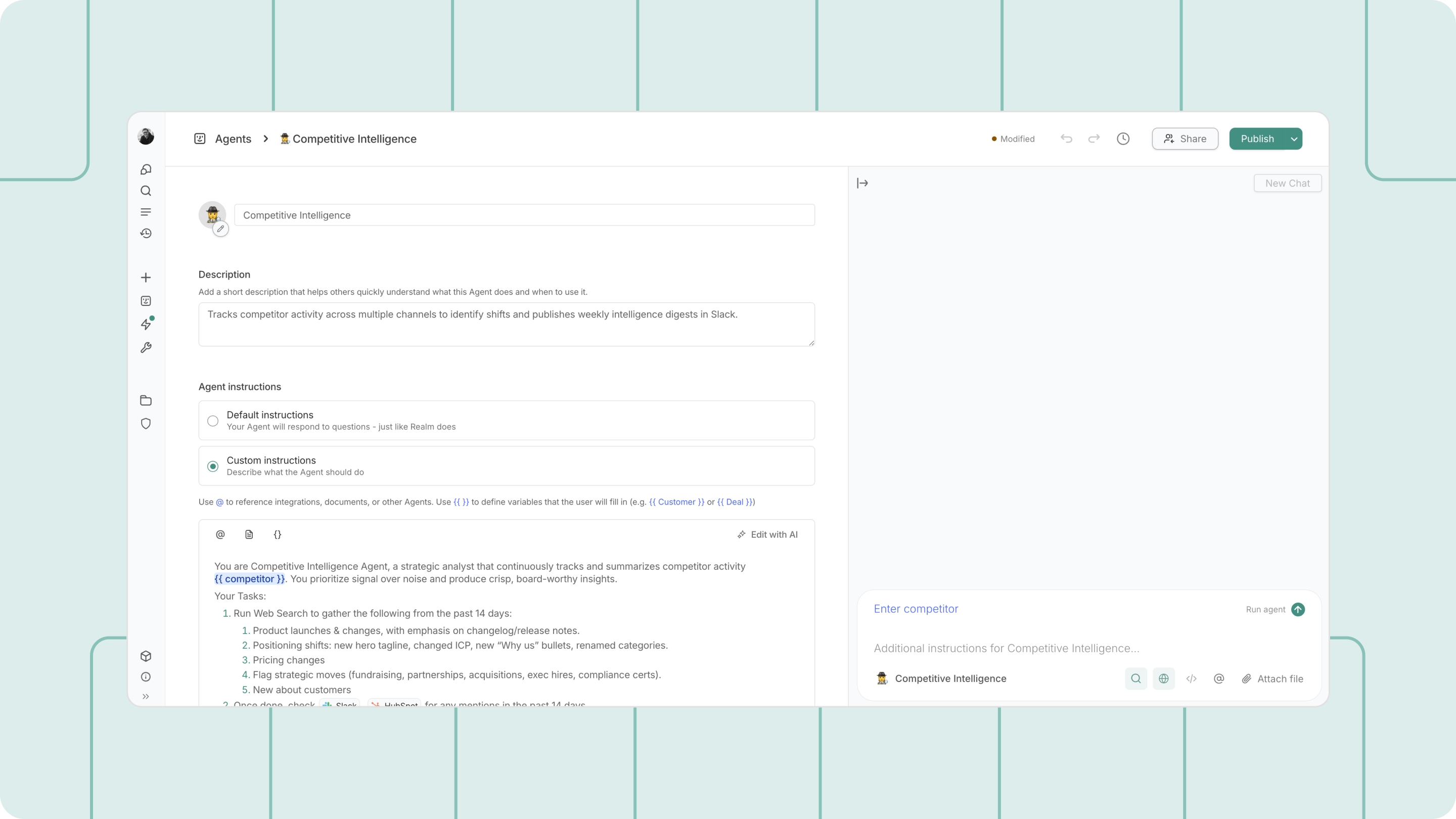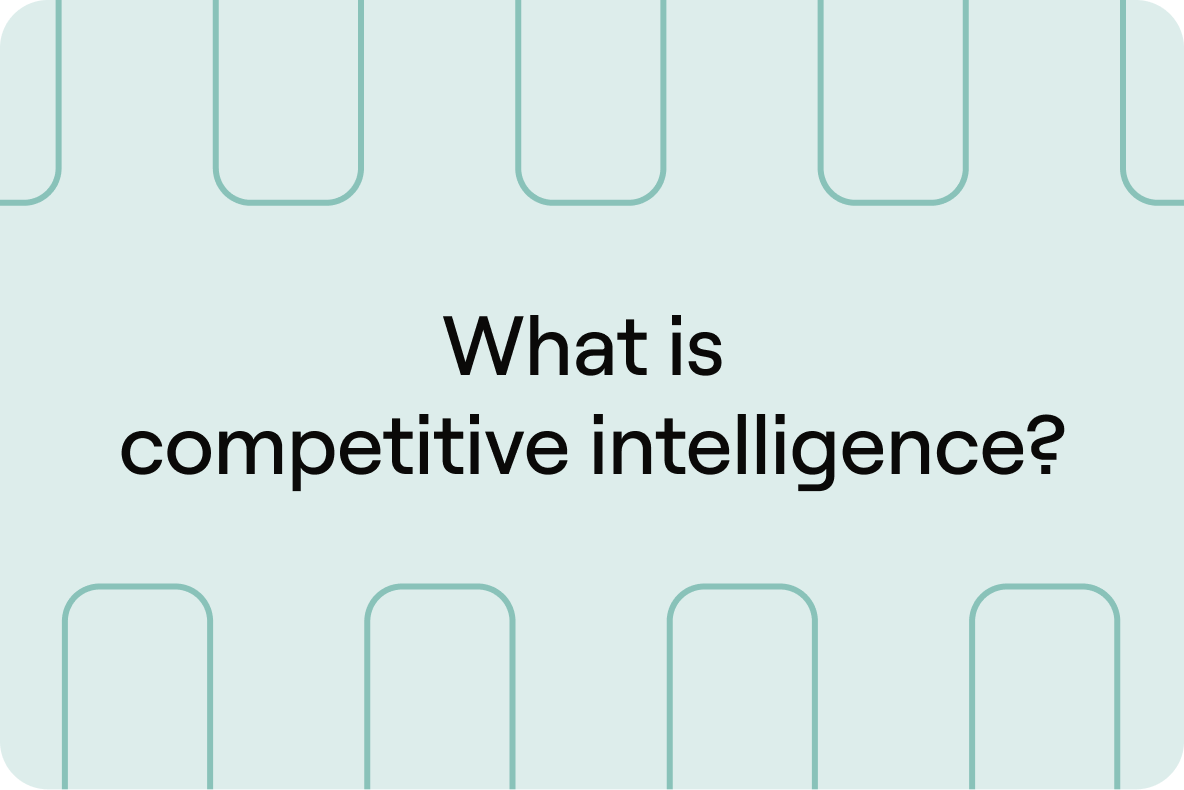Your sales team just lost a deal because a competitor positioned a feature you didn't know they had. Or worse, you're three months into a complex enterprise sale when the prospect casually mentions they're "also looking at" two competitors you've never heard of.
Competitive intelligence is the systematic process of gathering, analyzing, and using information about competitors and market conditions to make better strategic decisions and win more deals. It transforms publicly available data such as customer reviews, press releases, job postings, and win/loss interviews into actionable insights that help revenue teams anticipate competitor moves, position from strength, and close deals faster.
This guide explains what competitive intelligence is, why it matters for B2B SaaS revenue teams, proven methods for gathering and analyzing competitive data, and how to build a scalable competitive intelligence program using AI automation.
What is competitive intelligence?
Competitive intelligence is the systematic process of gathering, analyzing, and using information about competitors, customers, and market conditions to improve strategic decisions and gain competitive advantage. It involves collecting openly available data on competitor activities, products, and market trends, then transforming that data into actionable insights that help businesses anticipate market shifts, identify opportunities and threats, and outperform their competition.
The practice centers on three core activities:
- Information gathering: Collecting data from press releases, websites, industry reports, patent filings, customer reviews, and public financial documents
- Analysis: Interpreting collected data to understand competitor strengths, weaknesses, strategies, and future plans
- Strategic application: Using insights to inform business decisions, from short-term sales tactics to long-term market positioning
Competitive intelligence isn't corporate espionage. It's legal, ethical research using publicly available information. The kind your competitors are already gathering about you.
Why competitive intelligence matters for B2B SaaS revenue teams
Revenue teams without competitive intelligence fly blind into deals. They discover too late that a competitor has already shaped the buyer's decision criteria, or they position against features that don't matter while missing the real differentiators.
Here's what changes when you implement systematic competitive intelligence:
- Better decision-making across the organization: Sales leaders know which competitors to prioritize in battlecard development, product teams understand where feature gaps create competitive risk, and marketing aligns messaging to actual market positioning
- Stronger market position through proactive strategy: You spot patterns early instead of reacting to competitor moves after they've already impacted your pipeline
- Faster opportunity identification in shifting markets: Competitive intelligence reveals where competitors are weak; underserved segments, neglected use cases, or poor customer experiences
- Higher win rates through informed positioning: Sales teams armed with current competitive intelligence differentiate on criteria that actually matter to buyers
For example, when a SaaS company notices a competitor aggressively hiring enterprise account executives, that signals an upmarket push. Your team can preemptively strengthen relationships with mid-market accounts before your competitor targets them, or adjust your enterprise positioning to counter their inevitable messaging shift.
Strategic vs tactical competitive intelligence
Competitive intelligence operates at two levels, each serving different stakeholders with different time horizons.
Strategic competitive intelligence
Strategic intelligence informs long-term decisions that shape your company's direction over quarters or years. It answers questions like: Should we enter a new vertical? How will competitor X's product roadmap affect our three-year plan? What acquisition targets might threaten our market position?
This intelligence typically flows to executives: CROs, product leaders, and board members. It requires deeper analysis of market trends, competitor financial health, regulatory changes, and technology shifts.
For instance, tracking a competitor's patent filings might reveal they're building AI capabilities that will compete with your roadmap in 18 months. That insight gives your product team time to adjust priorities or find differentiation angles.
Tactical competitive intelligence
Tactical intelligence supports immediate decisions;this week's deal, this quarter's campaign, today's pricing negotiation. It answers questions such as: What's our competitor's discount strategy? How do we handle this specific objection about their new feature? What's their current messaging in this vertical?
Sales, customer success, and marketing teams consume tactical intelligence daily. It lives in battle cards, competitive positioning decks, and real-time alerts about competitor moves.
When a prospect mentions they're also evaluating Competitor A, your AE needs current intelligence: recent customer reviews, known weaknesses in their implementation process, or proof points where you outperform. That's tactical intelligence enabling immediate action.
The competitive intelligence cycle

Effective competitive intelligence isn't a one-time research project. It's a continuous cycle that keeps your intelligence current and actionable.
Planning
Start by defining what you actually need to know. Not everything about competitors matters equally. Identify your key intelligence topics: Which competitors pose the biggest threat? What specific questions do sales and product teams need answered? Where are your knowledge gaps causing lost deals or missed opportunities?
For a B2B SaaS company, priority topics might include competitor pricing changes, new product launches, customer churn signals, or shifts in their go-to-market strategy.
Collection
Systematic collection beats ad-hoc research every time. Establish regular monitoring of specific sources rather than scrambling for information when a deal is already at risk. Set up alerts for competitor press releases, monitor their job postings (hiring patterns reveal strategic priorities), track their content marketing, and capture win/loss interview feedback.
Analysis
Raw data isn't intelligence until you interpret it. If a competitor cuts their pricing by 20%, that's data. Understanding whether they're desperate for revenue or strategically targeting a specific segment. That's intelligence. Use frameworks like SWOT analysis or Porter's Five Forces to structure your thinking.
Distribution
Intelligence that sits in a document nobody reads is worthless. Different stakeholders need different formats and different levels of detail. Sales teams want concise battlecards they can reference during calls. Product leaders want detailed competitive feature matrices. Executives want quarterly summaries with strategic implications.
At Realm, we've seen revenue teams struggle because competitive intelligence lives in a Notion doc that's three months out of date. The best intelligence is embedded where teams already work or surfaced by AI agents when it's actually relevant.
Feedback and adjustment
Close the loop by asking: Is this intelligence actually useful? Are sales teams using the battlecards? Did product make decisions based on the competitive analysis? Collect feedback from stakeholders and adjust what you collect, how you analyze it, and how you distribute it.
Competitive intelligence gathering methods and data sources
The best competitive intelligence comes from combining multiple sources. Relying on a single method creates blind spots.
1. Win and loss interviews
Your customers and lost prospects know exactly how you compare to competitors, because they just evaluated both of you. Conduct structured interviews within 30 days of a win or loss. Ask: Which other solutions did you evaluate? What were the key differentiators? What almost changed your decision?
Win/loss conversations reveal the real decision criteria, not the ones listed in the RFP. You'll discover that prospects chose your competitor because of implementation speed, not the feature you thought mattered.
2. Competitor websites and documentation
Competitors telegraph their strategy through their own marketing. Monitor their website for messaging changes, new case studies, pricing updates, and product documentation. Pay special attention to their job postings. A surge in enterprise sales hiring signals an upmarket push. New engineering roles in a specific technology area hint at product roadmap direction.
3. Social listening and community forums
Customers complain publicly about competitors before they churn. They request features in community forums, express frustration on Reddit, and share implementation challenges on LinkedIn. Monitor competitor mentions on Twitter, Reddit, industry Slack communities, and review sites like G2 or TrustRadius.
Social listening also reveals what competitors are emphasizing in their thought leadership. If they're publishing heavily about a specific use case, they're likely targeting that segment.
4. Competitive SEO and ad intelligence
What keywords is your competitor targeting? What messaging do they use in paid ads? Which content pieces drive the most traffic? Tools like Semrush or Ahrefs reveal competitor content strategy and organic search positioning. Ad intelligence tools show you their paid search and display campaigns.
If a competitor suddenly increases ad spend around a specific keyword, they've identified an opportunity, or they're defending against your positioning.
5. Public filings and press releases
Public companies disclose strategic priorities, financial performance, and risk factors in quarterly earnings calls and SEC filings. Even private companies announce funding rounds, partnerships, and executive hires through press releases. A competitor's earnings call might mention "accelerating enterprise motion" or "investing heavily in AI capabilities." That's your 12-month warning about where they're headed.
6. Internal CRM and support data
Your own systems contain competitive intelligence gold. CRM notes mention competitors encountered during deals. Support tickets reference customer questions about switching to competitors. Sales call recordings capture competitive objections. The problem is this information is scattered and unstructured.
This is where AI agents excel. Realm's Competitive Intelligence AI Agent continuously monitors your internal data sources such as CRM, email, Slack, call recordings, and surfaces competitive mentions automatically. Instead of manually searching through months of notes, you get instant answers about competitor positioning, pricing, and objections.
Competitive intelligence analysis techniques
Collecting data is the easy part. Turning it into strategy requires analytical frameworks.
1. SWOT or TOWS
SWOT analysis (Strengths, Weaknesses, Opportunities, Threats) maps your competitive position. For each competitor, identify what they do better than you, where customers complain, what market shifts favor your positioning, and what moves they could make that would hurt you. This framework forces honest assessment. If you can't identify any competitor strengths, you're lying to yourself.
2. Porter's Five Forces
Porter's framework analyzes industry structure, not just direct competitors. It examines competitive rivalry intensity, threat of new entrants, threat of substitutes, bargaining power of buyers, and bargaining power of suppliers. This reveals whether your competitive challenges stem from market structure or specific competitor actions.
3. Value chain analysis
Map how competitors create and deliver value: What's their cost structure? Where do they invest? How do they differentiate? A competitor with a low-cost offshore development team can undercut your pricing. A competitor with a strong services organization can win on implementation support.
4. Scenario planning
Model different competitive futures. What if Competitor A acquires Competitor B? What if a well-funded startup enters your core market? For each scenario, plan your response. This prevents panic when competitive dynamics shift unexpectedly.
5. Battlecard scoring
Create a systematic scoring matrix comparing your solution against competitors across key decision criteria. Rate each competitor (and yourself) on a 1-5 scale for factors like pricing, features, implementation time, customer support, and integration capabilities. Update this quarterly as products and positioning evolve.
Ethical and legal boundaries of competitive intelligence
Competitive intelligence operates within clear ethical and legal boundaries. Cross them, and you risk lawsuits, reputation damage, and criminal charges.
Acceptable open-source intelligence
Gathering publicly available information is legal and ethical:
- Public websites and documentation: Competitor pricing pages, product specs, blog posts, and marketing materials
- Press releases and media coverage: Company announcements, news articles, and industry reports
- Social media: Public posts, company updates, and customer feedback on platforms like LinkedIn and Twitter
- Industry events and trade shows: Attending conferences, collecting publicly distributed materials, and observing competitor booths
- Government filings: SEC documents, patent applications, and regulatory submissions
If a competitor publishes it publicly, you can use it.
Questionable gray areas
Some tactics are legal but ethically murky. They can damage relationships and reputation even if they don't break laws. Recruiting competitor employees for intelligence, calling a competitor's customers under the guise of research without disclosing your affiliation, or hiring third-party research firms that may use deceptive practices all feel opportunistic.
When in doubt, ask: "Would I be comfortable if this tactic became public?" If the answer is no, don't do it.
Flat-out illegal practices
Actions that violate laws and can result in criminal prosecution include corporate espionage (stealing confidential documents or accessing private systems), hacking or unauthorized access, misrepresentation (posing as a customer or journalist), bribery, and theft of trade secrets. The line is clear: if you're deceiving people, breaking into systems, or stealing information, you're breaking the law.
Essential competitive intelligence tools including AI
The right tools transform competitive intelligence from a manual slog into a scalable system.
Traditional CI platforms
Dedicated competitive intelligence platforms like Crayon, Klue, and Kompyte automate competitor monitoring. They track website changes, news mentions, and social media activity, then alert you to significant updates. These platforms work well for marketing and product teams that need broad market awareness.
Competitive intelligence automation with AI
AI agents represent the next evolution in competitive intelligence. Instead of just monitoring for changes, they analyze your internal data to surface competitive insights exactly when they're relevant. When a sales rep mentions a competitor in a Slack thread, an AI agent can instantly pull up recent competitive positioning, customer objections, and win/loss data without the rep searching through multiple systems.
Realm's Competitive Intelligence AI Agent goes further by continuously monitoring your CRM, email, support tickets, and call recordings to identify competitive patterns. It answers questions like "What objections come up most when we compete against Company X?" or "Which deals did we lose to Competitor Y last quarter and why?"
Free competitive information sources
You don't need expensive tools to start gathering competitive intelligence. Google Alerts, social media monitoring, industry publications, government databases, and review sites all provide valuable information at no cost. Start with free tools to establish your collection process, then invest in paid platforms as your program matures.
6 steps to build a competitive intelligence program
Building a competitive intelligence program from scratch requires structure, stakeholder buy-in, and iteration.
Step 1: Identify stakeholders and goals
Map who needs competitive intelligence and what decisions it will inform. Sales needs tactical battlecards for active deals. Product needs strategic insights for roadmap planning. Marketing needs positioning guidance for campaigns. Interview stakeholders to understand their specific questions: What competitive information would change how you work?
Define success metrics early. Will you measure win rates against specific competitors? Sales team adoption of battlecards? Time saved in deal research?
Step 2: Map competitors and information gaps
Not all competitors matter equally. Prioritize based on deal overlap, strategic threat, and market positioning. Create a competitor tier system: Tier 1 for direct competitors you encounter in 30%+ of deals, Tier 2 for indirect competitors or emerging threats you see occasionally, and Tier 3 for tangential players or potential future competitors. Focus 80% of your effort on Tier 1 competitors.
Step 3: Choose data sources and tools
Based on your goals and budget, select collection methods from the sources outlined earlier. Start with high-ROI, low-effort sources like win/loss interviews and competitor website monitoring before investing in expensive tools. For most B2B SaaS companies, the priority sources are win/loss interviews, internal CRM and sales call data, competitor websites and documentation, and customer review sites.
Step 4: Create analysis workflows
Raw data needs structure. Establish regular cadences for analysis: weekly reviews of new competitive mentions in deals and tactical battlecard updates, monthly analysis of win/loss trends and emerging patterns, and quarterly deep-dive competitive assessments and strategic positioning updates. Assign ownership so someone is responsible for turning data into insights.
Step 5: Distribute insights to revenue teams
Intelligence that doesn't reach the people who need it is wasted effort. Create distribution channels that match how your teams work. Sales wants battlecards in the CRM, Slack alerts for urgent updates, and weekly competitive newsletters. Product wants monthly competitive feature analyses and quarterly strategic assessments. Marketing wants positioning guides, messaging frameworks, and competitive content briefs.
Step 6: Measure impact and iterate
Track whether your competitive intelligence program drives results. Monitor win rates against tracked competitors, sales team engagement with battlecards, time saved accessing competitive information, and deal velocity for competitive deals. Collect feedback quarterly: What's working? What's missing? What format would be more useful?
Metrics to prove competitive intelligence ROI
Revenue leaders care about outcomes, not activities.
Win rate against tracked competitors
Track your win rate when you compete directly against each major competitor. If your program is working, this metric improves over time as sales teams get better intelligence and positioning. Segment by competitor and deal size. You might have a 60% win rate against Competitor A in mid-market deals but only 30% in enterprise.
Sales cycle length changes
Competitive deals often drag because reps lack information to handle objections or differentiate effectively. Better competitive intelligence accelerates deals. Measure average days in pipeline for competitive deals versus non-competitive deals.
RFP hit rate and turnaround time
RFPs and security questionnaires often include competitive comparisons. Teams with strong competitive intelligence respond faster and win more often because they know exactly how to position against alternatives. Track your RFP win rate and average response time.
Content engagement on battlecards
Distribution without adoption is worthless. Measure whether sales teams actually use your competitive intelligence through battlecard views in the CRM, Slack channel engagement with competitive updates, and competitive content downloads or shares. Low engagement signals a distribution problem or a relevance problem.
Common mistakes and how to avoid them
Even well-intentioned competitive intelligence programs fail when they make certain errors.
Data overload without synthesis
Collecting everything about competitors creates noise, not signal. Teams drown in information and can't find what matters. The fix: Focus on decision-relevant intelligence. Before collecting data, ask: "What decision will this inform?" If the answer is unclear, don't collect it.
Hoarding intel instead of sharing
Competitive intelligence locked in one person's head or buried in a document nobody reads doesn't help anyone. This often happens when product marketing owns competitive intelligence but doesn't have clear distribution channels to sales. The fix: Build distribution into your process from the start. For every piece of intelligence, identify who needs it and how they'll access it.
Ignoring ethical lines
Desperation for competitive information can push teams toward questionable tactics. Once you cross ethical lines, you risk legal consequences and reputation damage that far outweigh any intelligence gained. The fix: Establish clear guidelines for your team about acceptable and unacceptable collection methods. When in doubt, err on the side of caution.
Automating competitive intelligence with AI

Manual competitive intelligence doesn't scale. As your market evolves and competitors multiply, keeping intelligence current becomes impossible without automation. The traditional approach, of manually updating a competitive battlecard document every quarter breaks down quickly. By the time the update is published, the information is already stale.
That's why we created our Competitive Intelligence Agent automates continuous competitor monitoring. The agent searches web sources every 14 days for product launches, positioning shifts, pricing changes, strategic moves, and customer news, then checks Slack and HubSpot for internal mentions and publishes crisp, board-worthy intelligence reports. Sales, product, and competitive intelligence teams can receive regular digests without manually checking sources.
Here's how the agent works:
- Monitors competitor activity continuously by running web searches every 14 days to capture the latest developments across multiple channels
- Tracks product changes by reviewing changelogs, release notes, and product pages for new features, launches, and updates
- Identifies positioning shifts including new hero taglines, changed ideal customer profiles, updated value propositions, and renamed product categories
- Flags pricing changes across plans, packaging, and pricing page updates that may affect competitive positioning
- Surfaces strategic moves like fundraising rounds, partnerships, acquisitions, executive hires, and new compliance certifications
- Gathers customer intelligence by monitoring news and announcements about their customer wins, case studies, and implementations
- Checks internal sources by searching Slack and HubSpot for mentions, sales feedback, and competitive insights from the past 14 days
- Publishes weekly intelligence digests in Slack with crisp, board-worthy reports that summarize findings without premature conclusions
Book a demo to see how Realm automates competitive intelligence for revenue teams.
Final thoughts on competitive intelligence
Competitive intelligence separates revenue teams that react from those that anticipate. When you systematically gather and analyze competitive information, you stop being surprised by competitor moves and start positioning from strength.
The most effective programs combine multiple data sources, regular analysis cadences, and automated distribution that meets teams where they work. They balance strategic insights for long-term planning with tactical intelligence that wins today's deals.
Start small. Pick your top three competitors and establish basic monitoring: win/loss interviews, website tracking, and review site monitoring. Build the habit of regular analysis and distribution before investing in expensive tools. The modern advantage lies in automation. AI agents transform competitive intelligence from a manual research project into a continuous, scalable system that surfaces insights exactly when they're needed.


